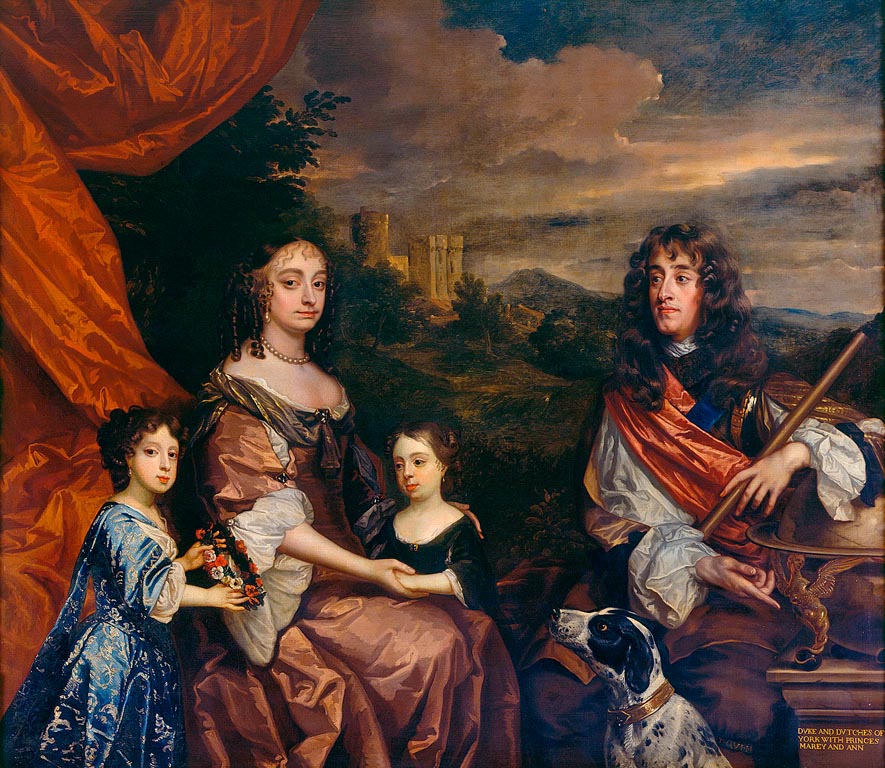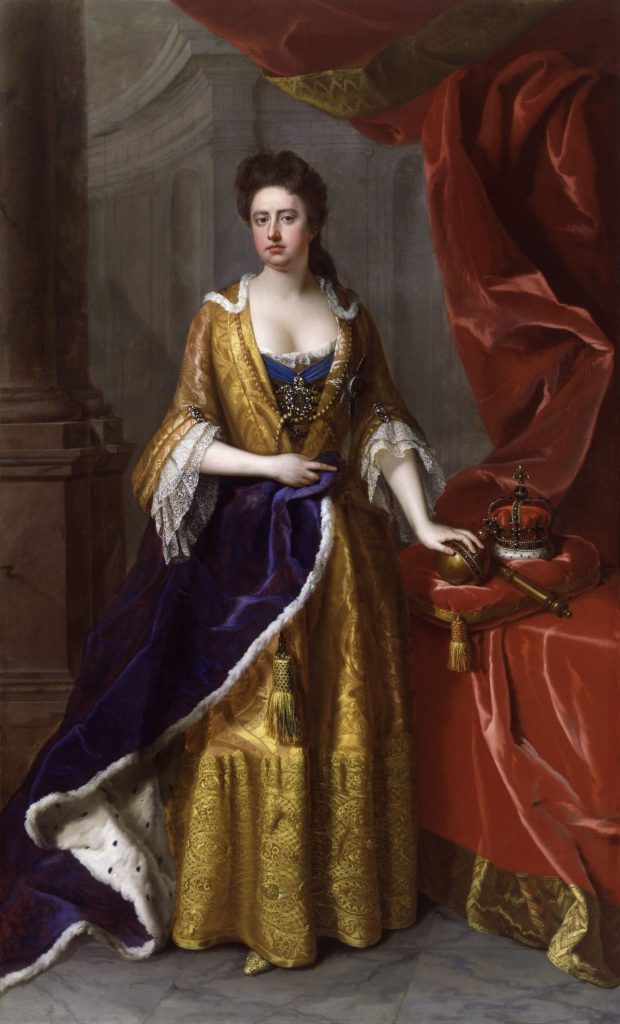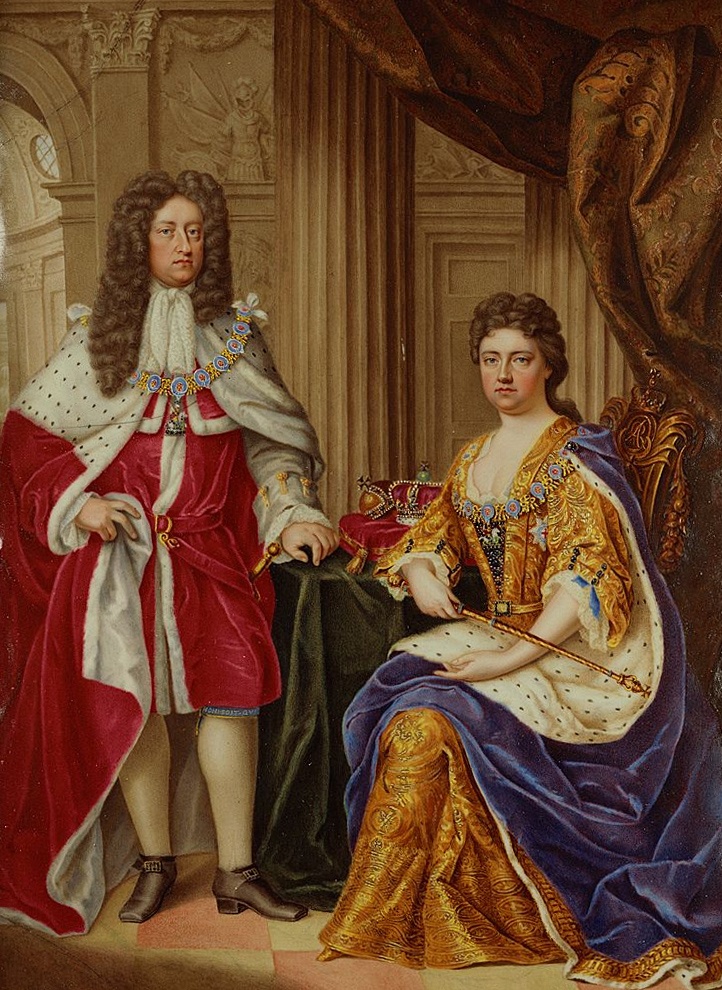Queen Anne of Great Britain was the last monarch of the House of Stuart, reigning as Queen of England, Scotland and Ireland from 1702-1707 and Queen of Great Britain and Ireland from 1707-1714. During her reign, the kingdoms England and Scotland merged as one to become Great Britain under the Acts of Union on May 1, 1707. Throughout her life, Anne suffered from terrible health and of all her seventeen pregnancies with husband Prince George of Denmark, not one lived to be past eleven years old.
On February 6, 1665, Anne was born at St. James’s Place, London to James, Duke of York and Anne Hyde as their fourth child and second daughter. Her elder sister Mary would be the only one of her siblings to live to adulthood. Anne’s uncle—her father’s older brother—was King Charles II. She had an Anglican baptism at the Chapel Royal in St. James’s with her sister Mary and the Duchess of Monmouth as her godmothers and Archbishop of Canterbury, Gilbert Sheldon as her godfather.
For some time, Anne lived in France with Queen Henrietta Maria, her paternal grandmother, near Paris to get treated for a bad eye condition she developed as a child. When her grandmother died in 1669, Anne lived with her aunt Henrietta Anne, Duchess of Orléans until she died in 1670. From there, Anne returned to England, but her mother died on March 31, 1671. Around that same year, she also met Sarah Jennings, future wife of Anne’s most important general John Churchill. The two continued their friendship throughout their lives.
Anne and Mary were brought up at Richmond, London and were kept separated from their Father, as per tradition in the royal family. Their uncle Charles II instructed them to be raised as Protestants. Colonel Edward and Lady Frances Villiers, their caretakers, educated them mainly in the Anglican church and Henry Compton, Bishop of London, was Anne’s preceptor. In 1673, their father married Mary of Modena who would give birth to many children, but none of them would survive infancy. So, Anne stayed third in line to the throne after her father and sister Mary. Anne and Mary of Modena most likely got along very well and that she had a healthy relationship with her father as well.
When Mary married William of Orange, their Dutch first cousin, in November of 1677, Anne was kept confined in her room due to smallpox. Once Anne recovered though, her sister had moved to the Netherlands with her husband. Shortly after, Lady Frances Villiers died of the disease and Lady Henrietta Hyde, her aunt, became her governess instead. The next year, Anne went with her stepmother Mary of Modena to visit her sister Mary in the Netherlands. The two of them stayed with Mary for two weeks before returning to England. In August of 1679, Anne also visited her father and stepmother in Brussels and then returned in October. From July of 1681 to May of 1682, she also visited them in Edinburgh at Holyrood Palace. Meanwhile, King Charles was searching for a suitable prince to marry Anne that Louis XIV of France would also accept. With the Danes and French being strong allies, Charles looked towards marrying her to a Danish prince. So, her uncle Laurence Hyde along with a few others negotiated a marriage treaty between Anne and King Christian V’s younger brother Prince George of Denmark.
On July 28, 1683, Anne married Prince George of Denmark in the Chapel Royal. The two stayed very devoted and faithful to each other, unlike many arranged marriages of the time. They were given buildings in London to serve as their residence called the Cockpit at the Palace of Whitehall. Not long after the marriage, Anne was pregnant, but the baby girl was born stillborn the next May. Over the course of the following two years, Anne gave birth to daughters Mary and Anne Sophia. Soon George and their daughters came in contact with smallpox. George recovered, but their daughters did not and died February of 1867. Mary was not quite two years old and Anne Sophia was not even a year. The deaths were very hard for them, as they would often be seen just sitting beside each other holding hands in mourning. Throughout the course of the next thirteen years, Anne went through fourteen more pregnancies, many of them stillborn or miscarried. Only one survived a day: Prince William, Duke of Gloucester born in 1689. However, he died in 1700 at age eleven after suffering through poor health his whole life. Anne and George outlived all their children and despite her many pregnancies, most of them did not live past a day.
Charles II died in 1685 and was then succeeded by Anne’s father who became James II of England and Ireland and James VII of Scotland. Her father, a catholic, began appointing catholic man to his council and high military positions. At this point, Anne and her family were the only remaining members of the royal family still of Protestant faith while her sister Mary was living in the Netherlands. James even asked Anne to give her daughter a Catholic baptism, but she refused and told her sister that “The Church of Rome is wicked and dangerous”. Anne continued to have troubles with her pregnancies though, miscarrying yet again then going through another stillbirth after her daughters died from smallpox. Mary of Modena gave birth to a son not long after in June of 1688. named James Francis Edward. Anne was in Bath after writing to her sister saying that she believed Mary was not actually pregnant and then suffering through another miscarriage that April. At the time of James Francis Edward’s birth Anne was not present either because she believed the pregnancy was fake or had become ill.
William of Orange, Anne’s brother-in-law, invaded England on November 5, 1688, which later became known as the “Glorious Revolution”. He was able to depose of King James and take the throne with Mary. All along, Anne had known of these plans from constant correspondence with her sister even though James had forbade them to visit. Anne approved of William’s plan as well and refused to help her father. Sarah Churchill, one of the most influential woman in England during her time and a very close friend of Anne’s, sided with William as well, was ordered to be arrested but fled with Anne from Whitehall. They spent a night with Bishop Compton then arrived in Nottingham on December 1 were they would stay for two weeks. The two were then escorted out of Nottingham, and Anne was reunited with her husband in Oxford. She returned to London on December 19 and met with William upon her arrival. James fled to France four days later. Soon after, it was declared that James had abdicated by running away to France and that William and Mary would take the throne. Then on July 24, 1689 Anne gave birth to Prince William, Duke of Gloucester who would be her only child to survive infancy, though he was often ill from the time he was born until his death eleven years later. Because William and Mary did not have any children, Prince William was a possible heir.
Anne became angry with William and Mary first when they refused to allow her to use Richmond Palace and give her a parliamentary allowance. When William refused to let George served in the military, Anne’s anger worsened and her close relationship with her sister became strained. William and Mary were worried though that if Anne was more financially independent, their influence over her would become weaker. John Churchill, who was given the Earldom of Marlborough, was dismissed from William’s offices when rumors of him conspiring with James’s followers surfaced. The public was still in support of the Marlboroughs, so Anne refused to dismiss Sarah from her household and continued to take her to social events. Lord Chamberlain removed Sarah, or Lady Marlborough, from the royal household, causing Anne to leave her royal home and move to Syon House in London where the Duke of Somerset was living. Soon, Anne was stripped of her guard of honour and was forbidden to be seen by courtiers and ignored by civic authorities. Anne gave birth to a son that April who died right after being born and was visited by Mary, who did not comfort her sister but instead got made at her for her friendship with Sarah. Anne moved to Berkeley House in Piccadilly shortly after and was never to speak to or see her sister again. In March of 1693, she gave birth again, but sadly to a stillborn daughter.
In 1694, Anne became William’s heir apparent after Mary died that year due to smallpox. After, the two rekindled their friendship and Anne was given back her previous titles and was from then on allowed to live in St. James’s Palace. Marlborough was also given his offices back and Berkeley House became a place for social events and activities for courtiers. Six years later, Anne had gone through many miscarried and stillborn pregnancies. When she miscarried a son, her final pregnancy ended on January 25, 1700, not long before her only surviving child William died. Throughout her life, she had at least twelve miscarriages and stillbirths and of her four living children, only one lived past two, and two died the day they were born. There are many diseases or reasons historians have suggested as to why she suffered through so many stillbirths and miscarriages, though it is unknown as to what the actual cause was.
From 1698 onwards, Anne also suffered through gout. For the rest of her life, she was unable to walk because of it and was carried around in what is called a sedan chair or she just used a wheelchair. A one-horse chaise was used around her estate. Because she could no longer walk, Anne started gaining weight, and according to close friend Sarah “she grew exceeding gross and corpulent.”
William, Duke of Gloucester died on July 30, 1700 at eleven years old. Anne and George were grieved for their child overwhelmingly. She ordered for her household to observe a mourning day every year on the date of his death. This left Anne as the only person in the line of succession that had been earlier established in the Bill of Rights 1689. By the Act of Settlement 1701, Sophia, Electress of Hanover would be given the crown if Anne and George failed to have any more children.
On March 8, 1702, William III died, and Anne became Queen. Right away, she was a very popular queen. Three days later, she made her first speech to Parliament and spoke of how she wanted only for England to be happy and distanced herself away from the Dutch William. George was given the title of Lord High Admiral, which ultimately put him in charge of the Royal Navy. marlborough was then put in control of the army when appointed Captain-General and later created a Knight of the Garter and duke. The now Duchess of Marlborough, still a very close friend of Anne’s, became Groom of the Stole, Mistress of the Robes, and Keeper of the Privy Purse. Because of her gout affliction, Anne was carried to Westminster Abbey during her coronation on April 23, 1702 sitting on an open sedan chair that had a low back so her train followed behind. It was not long after that England began fighting with Austria and the Dutch Republic against France and Spain in the War of Spanish Succession.
Early on in her reign, Anne declared that it was necessary England and Scotland combine to become one kingdom after Ireland and England already had. In October of 1702, a group of English and Scottish officials met to discuss these terms, but they were unable to reach an agreement and broke up in February of 1703. Not long after, the Act of Security in Scotland was passed. It gave power to the Estates to choose the next monarch of Scotland if Anne did not have any more children. She did not give the act royal assent until the next year when the Estates threatened to withhold their supply from England. English Parliament in return passed the Alien Act 1705. This act declared Scottish subjects aliens among other things unless they repealed the Act of Security or united with England. The Scottish Estates then decided to unite with England, who repealed the Alien Act. Anne appointed new commissioners to negotiate a union between England and Scotland in 1706. It was ratified in January and March of 1707 and the two kingdoms became Great Britain under the Acts of Union. Anne was a great supporter of the two kingdoms coming together to form one union throughout her life prior to the Acts of Union.
During her reign, the two-party system also began to develop. Anne was much more in favor of the Tories as they were supportive of the Anglican church, which she was a member of, than the Whigs. Her relationship with Sarah, Duchess of Marlborough began to deteriorate when Sarah suggested Anne appoint more Whigs, as she was not in favor of the Tories. Anne began appointing more Whigs under influence from friends and others around her, but that worsened many of her friendships and strengthened those with other Tories. Abigail Hill, one of the women of the bedchamber, became closer with Anne, which angered Sarah. Even more so, Sarah was angry when Abigail moved into her rooms at Kensington Palace. Sarah even came to court implying that Anne and Abigail had a lesbian relationship, though that was most likely untrue and Abigail was just a good friend and servant to Anne. Sarah and Anne got in a terrible argument at a thanksgiving dinner after the Battle of Oudenarde when Anne did not wear jewels selected by Sarah, who then yelled at her to be quiet.
On October 28, 1708, Anne suffered through the death of her beloved husband, George. “His death has flung the Queen into an unspeakable grief. She never left him till he was dead, but continued kissing him the very moment his breath went out of his body, and ’twas with a great deal of difficulty my Lady Marlborough prevailed upon her to leave him,” a letter to General Cadogan from James Brydges said. Anne then wrote soon afterwards to Frederick IV of Denmark, her nephew, “the loss of such a husband, who loved me so dearly and so devotedly, is too crushing for me to be able to bear it as I ought.” She so desperately wanted to stay with his body at Kensington, but Sarah, Duchess of Marlborough pressured her to leave Kensington for St James’s Place, so she did. Sarah then removed George’s portrait from Anne’s bedroom, which angered Anne, and their relationship only became worse. On November 13 George was buried privately. Anne was so distraught over her husband’s death that she was forced to accept Whigs into her cabinet. The Whigs used George’s death as an advantage. Sarah refused to stop criticizing the friendship between Anne and Abigail such that Anne wrote to her husband asking him to make her stop. After April 6, 1710 on Maundy Thursday, the two of them never saw each other again.
That same year, Anne began dismissing the Whigs from her office, but kept Marlborough in his position as commander of the army. Abigail soon took over Sarah’s post as Keeper of the Privy in January of 1711. Her husband, Samuel Masham, was then made a baron, and the Duke of Marlborough was dismissed from office. A peace treaty was ratified afterwards that ended England’s involvement in the War of the Spanish Succession.
Between January-July of 1713, Anne had lost the ability to walk entirely. That Christmas she had a terrible fever and stayed in bed unconscious for hours on end. This began to spread rumors of her possible death, but she was able to recover. However, Anne was ill once more that March. She dismissed her Lord Treasurer, Robert Harley, 1st Earl of Oxford and Earl Mortimer from office after he had served many posts during her reign because she lost trust in him. Her doctors began blaming state matters on her straining health and constant stress as her health was worsening and worsening. Anne became so ill she was no longer able to attend cabinet meetings. On July 30, 1714, her ability to speak was rendered by a stroke. On August 1, 1714 Queen Anne of great Britain died at around 7:30 a.m at forty-nine years old at Kensington Palace, Middlesex. She was buried at Henry VII Chapel besides George and her children on August 24. George, Elector of hanover succeeded her as King.






